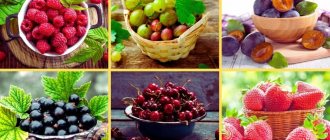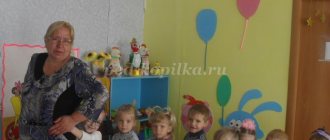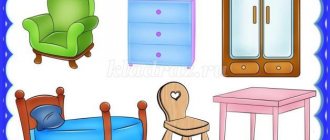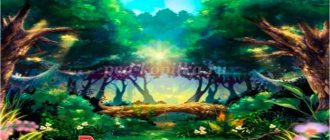Summary of an open comprehensive lesson on the topic: “Visiting Kolobok” in the junior group
GBOU secondary school No. 10 SPDS "Yagodka", Samara region, Zhigulevsk
Teacher of the first category
Link to the article, when indicated in the bibliography (according to GOST R 7.0.5-2008):
Zakharova O.E. Summary of an open comprehensive lesson on the topic: “Visiting Kolobok” in the junior group // Sovushka. 2015. N1. URL: https://kssovushka.ru/articles/e-sovushka.2015.n1.00006.html (access date: 12/19/2021).
Tasks
Educational objectives: Teach the simplest generalizations, enrich children’s vocabulary, strengthen the ability to compare two equal groups of objects, consolidate children’s knowledge of geometric shapes and primary colors. Strengthen the ability to select objects based on 2 characteristics: shape and color, assemble a picture from 4 parts. Systematize children's knowledge about domestic animals and their cubs. Educational objectives: To develop the ability to focus attention on objects and phenomena of the subject-spatial development environment. Promote the formation of positive emotions. Developmental tasks: Develop the ability to establish simple connections between objects and phenomena.
PROGRESS OF THE CLASS
Educator. Guys, look who came to visit us (shows the bun). Who is this? Children. Kolobok Teacher. Yes, but look how sad he is. What happened Kolobok? Shall we help him? Kolobok. I left my grandmother, I left my grandfather, I rolled and rolled and got lost. Help me find my way home. Educator. Let's help the bun guys? Children. Yes, Educator. I suggest you go to the forest by train, take a ticket from me. You need to find a place with the same number of circles as on your “ticket” (children find the appropriate places) / Music is playing, children are riding the train. Teacher. So we got to the forest (music sounds). Kolobok, do you remember the road? How to be? And look, guys, Bunny is sitting there running around, let’s ask him. They come up to the table. Educator. Bunny, help us find the way to the bun's house. Bunny. I will help, just help me assemble the game. Each lid has its own home. I'm completely confused, Teacher. Oh, bunny, the guys love this. Really, guys? Children. Yes, Educator. Look, there are geometric shapes on the lids, only they are all different colors. These are their houses. You need to select houses according to shape and color. Sasha, what is your figure? Child. Yellow triangle. Educator. What kind of figure do you have, Zhenya? Child. Red Square. Educator. Right. Now everyone, together, find houses for your lids. Children complete the task, the teacher corrects and gives hints. Bunny. Oh, guys, how great you are. Follow this path, it will lead you straight to the Kolobok village. Educator. Guys, the path is not easy, you need to follow each other in these tracks. Walking on corrective paths. A bear comes across. Educator. Look where we've come. Who is this? Children. Bear. Educator. Mishka-bear, help us find the way to the kolobok’s house. Bear. I would help, but I’m very busy, all my dishes are broken, help me collect them, Teacher. We will help you, Mishka, right, guys? Sit down at the tables, I’ll give you boxes containing broken dishes, you need to collect them. There is a picture of this dish on the boxes, you can look at it and complete the task (children sit down and complete the task) Educator. Katya, what did you do? Child. Saucepan Educator. Vladik, what did you collect? Child. Sugar bowl Educator. Well done guys, everyone completed the task. How can you call all these pictures that you collected in one word? Let's say it together Children. Dishes Educator. Well done, and now Misha, show me where we need to go so that we can quickly get to the kolobok home Bear. Over there on that road is Educator . Guys, again the path is unusual, ribbed (The guys walk along the corrective path) Educator. Oh, guys, look, whose house is this? I wonder who lives in it? Look, a little fox sister lives here, and here she is. Fox. Hello guys. What are you doing in the forest? Children. We are looking for the house of the little fox . So he lives in the village. Let me see him off. Educator. No, fox, we know what you will do with the kolobok. Guys, remember what the fox did with the bun in the fairy tale? Children. Ate it. Educator. Yes that's right. We'd better bring it to him ourselves, Fox. Well, then at least play my favorite game with me. I have these caps, I need to pick up boxes for them. Who is depicted on them, how can you call them in one word? Children. Pets Fox. Right. Help me choose the right baby for each animal. Educator. Guys, take the boxes with cubs and choose a suitable mother for them (Children complete the task) Fox. Oh, guys, how great you all are, how smart and kind you all are. For this, I will take you to the kolobok’s home , Teacher. Thank you fox, you're not that bad. Fox. Get on your train, guys, I'll show you where to go (children sit on chairs, music sounds) Fox. Here is the kolobok’s stop, his grandparents live here, they are waiting for him, worried. Educator. Run, little bun, and don’t run away from home again without permission. Goodbye (the teacher escorts the bun behind the screen and comes back with a basket) Look what grandparents treated us to, cookies. And now it’s time for us to return to kindergarten, take your seats on the train, let’s go home (music sounds) Educator. What great fellows we are, we did a good deed and helped the bun. What else have we learned to do? Children's answers
Complex classes in the first junior group
Evgenia Fedorova
Complex classes in the first junior group
Lesson No. 1
Topic: 1. Speech game <<Who is telling?>>
2. Mathematical game <<Find all... >>
Target . 1. Strengthen the child’s ability to distinguish vegetables and fruits by appearance, develop auditory attention.
2. Consolidate knowledge of color, shape, size.
Developmental environment : Models of fruits and vegetables on a tray (apple, cucumber, carrot, etc.) magic multi-colored ropes (strips of adhesive tape 3 mm wide, carpet, geometric shapes
Content.
The teacher shows the children fruits and vegetables, invites them to take one item from the tray and name it: “I have an apple!” I have carrots! I have a big cucumber! And I have a small cucumber!>>
The teacher places one of the children next to him and with his back to the others (Fruits and vegetables are again on the tray). One of the children comes to the table, takes a fruit or vegetable from the tray and says: “I took and am holding an apple in my hand.” Then he puts it on the tray and returns it to its place. <<Guess who held an apple in his hand and told you about it?>>, asks the teacher.
If a child recognizes a friend by voice, everyone claps their hands, and the recognized one takes the place of the driver. If the child makes a mistake, he drives again.
Then the teacher invites the children onto the carpet, marks several circles with multi-colored ropes and says that these are houses in which different figures live. in one of them live large blue figures, and in the other triangular red ones, in the third there are large round figures (objects). Children select the figures and “place” them in the corresponding house (circle). The teacher praises the children and says that the children helped to correctly place all the figures in their homes.
Lesson No. 2
Topic: 1. Speech game <<Captains>>
2. Mathematical game <<What's extra? >>
Target. 1. Develop the ability to pronounce the sound [F] for a long time on one exhalation and repeatedly pronounce the sound [p] (p-p-p) on one exhalation.
2. Learn to identify similarities and differences between objects.
Developmental environment: Bowls of water and paper boats, several small red cubes and one green, one large red cube.
Content.
The children have basins of water and paper boats on their tables. Children sit on chairs and blow on the boats, pronouncing the sound [f] or [p].
The teacher explains that in order for the boat to move, you need to blow slowly, as to pronounce the sound [F], then the boat, with an even wind, moves smoothly and confidently.
“But then a gusty wind came,” says the teacher, “it blows unevenly: <<p-p-p>>
The teacher makes sure that when pronouncing the sounds [F] and [P], the child does not puff out his cheeks, but pronounces the sound [p] 2-3 times in one exhalation.
Finishing the game, the children and teacher sing together:
Wind-breeze,
Pull up the sail!
You drive the boat
To the huge river!
Next, the teacher draws the children’s attention to a large red cube and several small red cubes displayed on the carpet.
Questions.
What's on the carpet?
What color are they?
How many are there?
Which cube do you think is the odd one out? Why? (Big, since he is alone, and the rest are small) Then the teacher invites the children to close their eyes and adds one small
Summary of a comprehensive lesson in the second junior group “Let's help Kolobok”
Target:
Develop mental operations, attention, binocular vision; form spatial relationships “above”, “below” .
Continue to learn how to assemble a whole from parts.
Strengthen counting to 5, knowledge of geometric shapes .
Find similarities and differences between objects.
Fixing the color.
Develop children's attention, visual memory, tactile and taste sensations.
Material:
Set of geometric shapes, Kolobok, number cards with geometric shapes, wide and narrow scarves, paints, cut-out pictures, sample, “traffic light”, cards with the image - “House - Kolobok - forest”, “Wonderful bag”, apple, felt-tip pens, paints . An all-terrain vehicle built from chairs.
Progress of the lesson.
Kolobok appears .
The song Kolobok plays (recorded).
Educator: - Kolobok , why are you so sad?
Kolobok: - Help me, please, yesterday I was walking in the forest and lost my scarf.
Educator: - Children, do you want to help Kolobok?
Children: - We want!
Educator: - Before you go on a search, let's draw a route: connect - house - Kolobok - forest in one line, from top to bottom, Kolobok should be on the path. (Cards for each child).
Educator: - Kolobok has brothers, they also rushed to help him. The koloboks rolled and rolled, they hit a stump and fell apart, guys, do you want to help them?
Children: - We want.
Educator: - We need to collect them. (D/i. Fold the picture “Kolobok” according to the model. Cut pictures).
Kolobok helps with the teacher, rejoices at the collected koloboks
Educator: - Let's go on an all-terrain vehicle. Take your tickets (number cards with geometric shapes from 1 to 5), take your seats (numbers from 1 to 5 are pasted on the chairs). Let's check it out.
Educator: - Stop. What is this before us?
Children: - Traffic light.
Educator: - What kind of lights are shining at the traffic lights? What color is the top light? Average? Lower?
Children go out, approach the tables and lay out “Traffic Light” from the circles. Educator: - How many lights?
Children: - Three. Above is red. In the middle is yellow. Below is green.
Physical education lesson “We are drivers.” Green light - drivers drive through the entire group. Red stop. Yellow - getting ready, turning on the engine,
Educator: - We took seats in the “all-terrain vehicle”, according to the ticket and seat number. We approach the forest and go down the hill from top to bottom. Look to the left, how tall the Christmas trees are, and how much snow there is below (we look), also to the right (2 times).
- And how bright the sun is shining, how shiny the snow is - they closed the doors, opened them, blinked (2 times). The sun hid behind a cloud - we opened our eyes. We brake carefully. Let's go out.
There are different scarves on the tables (according to width).
Educator: - Choose the widest (narrow) scarf. How did you know that the scarf is narrow? (wide), apply, compare.
-Paint it with polka dots using any paint of your choice (with your finger).
Children color, select the desired stripe, carry it and give it as a gift.
Kolobok: - Thank you guys, you helped me out, and I prepared a gift for them, but what kind of gift it is, you have to guess.
“Wonderful bag” - children first determine by touch, then smell, taste, and each one says in Kolobok’s ear what is there (an apple).
The children thank Kolobok, he says goodbye and leaves.



